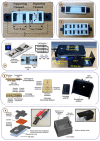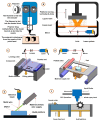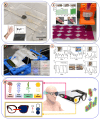A Review on 3D-Printed Miniaturized Devices for Point-of-Care-Testing Applications
- PMID: 40558422
- PMCID: PMC12191180
- DOI: 10.3390/bios15060340
A Review on 3D-Printed Miniaturized Devices for Point-of-Care-Testing Applications
Abstract
Integrating three-dimensional printing (3DP) in healthcare has modernized medical diagnostics and therapies by presenting various accurate, efficient, and patient-specific tailored solutions. This review critically examines the integration of 3DP in the development of miniaturized devices specifically tailored for point-of-care testing (PoCT) applications in healthcare. Focusing on progressive additive manufacturing techniques, such as material extrusion, vat photopolymerization, and powder bed fusion, the review classifies and evaluates their contributions toward designing compact, portable, and patient-specific diagnostic devices. Unlike previous reviews that treat 3DP or PoCT generically, this work uniquely bridges the technical innovations of 3DP with clinical applications by analyzing wearable sensors, biosensors, lab-on-chip systems, and microfluidic platforms. It highlights recent case studies, performance metrics, and the role of 3DP in enhancing diagnostic speed, accessibility, and personalization. The review also explores challenges such as material standardization and regulatory hurdles while outlining future directions involving artificial intelligence (AI), the Internet of Things (IoT), and multifunctional integration. This focused assessment establishes 3DP as a transformative force in decentralized and precision healthcare.
Keywords: 3D printing; additive manufacturing; biosensors; medical diagnosis; point-of-care testing; precision healthcare.
Conflict of interest statement
The authors declare no conflicts of interest.
Figures











Similar articles
-
Harnessing the potential of emerging additive manufacturing technologies as a game-changer for chemical and biosensing innovations.Rep Prog Phys. 2025 Aug 14;88(8). doi: 10.1088/1361-6633/adf7ba. Rep Prog Phys. 2025. PMID: 40763768 Review.
-
Lab-on-paper diagnostics for blood sample analysis: a review.Mikrochim Acta. 2025 Jul 2;192(8):467. doi: 10.1007/s00604-025-07303-w. Mikrochim Acta. 2025. PMID: 40601027 Review.
-
3D Printing Techniques and Their Applications to Organ-on-a-Chip Platforms: A Systematic Review.Sensors (Basel). 2021 May 10;21(9):3304. doi: 10.3390/s21093304. Sensors (Basel). 2021. PMID: 34068811 Free PMC article.
-
Signs and symptoms to determine if a patient presenting in primary care or hospital outpatient settings has COVID-19.Cochrane Database Syst Rev. 2022 May 20;5(5):CD013665. doi: 10.1002/14651858.CD013665.pub3. Cochrane Database Syst Rev. 2022. PMID: 35593186 Free PMC article.
-
Blockchain Integration With Digital Technology and the Future of Health Care Ecosystems: Systematic Review.J Med Internet Res. 2021 Nov 2;23(11):e19846. doi: 10.2196/19846. J Med Internet Res. 2021. PMID: 34726603 Free PMC article.
Cited by
-
The Collapse of Brain Clearance: Glymphatic-Venous Failure, Aquaporin-4 Breakdown, and AI-Empowered Precision Neurotherapeutics in Intracranial Hypertension.Int J Mol Sci. 2025 Jul 25;26(15):7223. doi: 10.3390/ijms26157223. Int J Mol Sci. 2025. PMID: 40806356 Free PMC article. Review.
References
-
- Ngo T.D., Kashani A., Imbalzano G., Nguyen K.T.Q., Hui D. Additive Manufacturing (3D Printing): A Review of Materials, Methods, Applications and Challenges. Compos. Part B Eng. 2018;143:172–196. doi: 10.1016/j.compositesb.2018.02.012. - DOI
-
- Mills D.K., Tappa K., Jammalamadaka U., Mills P.A.S., Alexander J.S., Weisman J.A. Advances in Manufacturing and Processing of Materials and Structures. CRC Press; Boca Raton, FL, USA: 2018. Medical Applications for 3D Printing; pp. 163–186. - DOI
-
- Chen G., Xu Y., Kwok P.C.L., Kang L. Pharmaceutical Applications of 3D Printing. Addit. Manuf. 2020;34:101209. doi: 10.1016/j.addma.2020.101209. - DOI
Publication types
MeSH terms
LinkOut - more resources
Full Text Sources
Miscellaneous

